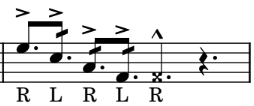Quarter Note = 180 vs Dotted Quarter = 180
Before we talk about the metronome, let’s start by defining what a time signature is.
There is a top note and a bottom note, kind of like a fraction, but no painful math to work out.
The top number is how many “beats” there are in a measure, and the bottom note says which type of note equals one beat.
4/4 is the most common, meaning there are four beats in a measure, each one being a quarter note.
3/4 time signature means there are three quarter notes in each measure.
12/8 is a little different. Now we have 12 beats in a measure, and each one is an eighth note.
This is often described as a “shuffle” feel, imagine swaying back and forth to groupings of three notes.
Okay, back to crazy DCI quad music.
Why would they do this?
While playing along to a metronome set at 180 bpm, these two subdivisions are interpreted the exact same way (after removing the double-bar notes).
They are both triplets, but do you see the difference?


The version on the bottom doesn’t have the “3” above the note groupings. BUT, since we are now in 12/8, the “3” is unnecessary because we are naturally playing in groups of three.
This is pretty easy to understand, but what about other subdivisions?

If you ignore the drags, these dotted eighth notes can just be played as regular eighth notes in 4/4. The dotted quarter note can be played as, you guessed it, just a regular quarter note!
Since our metronome is still clicking at 180 bpm, these counts will all match up.

Dotted 16th notes look very strange, and I don’t even want to think about how to count them. But again, we don’t have too. Since we are in 12/8, these can just be thought of as 16th notes. “1 e + a 2 +”

Okay, now we’re getting a little crazy, but let’s think about this. The measure is basically broken in half. The first half includes the first 9 notes. The second half is the 6 triplet notes and the quarter note, which is = to 3 more triplet notes (9 in first half, 9 in second half).
Since our metronome is still clicking 4 times for each measure, we know that the 9 triplet notes happen during 2 of the 4 clicks.
Let’s focus on just the accented notes. There will be 3 of them over the 2 clicks, so a 3:2 feel. Try this while marking time. The pattern starts with your left foot and the release will also be on your left foot.
Practice with your metronome until you get three evenly spaced notes, R R L, and then a R release exactly with the click of the met.
Once this is consistently smooth, add in the inner beats. After that, keep the same speed and finish out the measure.
Whew, glad that is done. My brain hurts.
See you next time!

